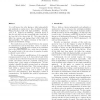Free Online Productivity Tools
i2Speak
i2Symbol
i2OCR
iTex2Img
iWeb2Print
iWeb2Shot
i2Type
iPdf2Split
iPdf2Merge
i2Bopomofo
i2Arabic
i2Style
i2Image
i2PDF
iLatex2Rtf
Sci2ools
RSA
1998
1998
Parallel randomized load balancing
It is well known that after placing n balls independently and uniformly at random into n bins, the fullest bin holds (logn=log logn) balls with high probability. Recently, Azar et al. analyzed the following: randomly choose d bins for each ball, and then sequentially place each ball in the least full of its chosen bins 2]. They show that the fullest bin contains only loglogn=logd + (1) balls with high probability. We explore extensions of this result to parallel and distributed settings. Our results focus on the tradeo between the amount of communication and the nal load. Given r rounds of communication, we provide lower bounds on the maximum load of ( rp logn=loglog n) for a wide class of strategies. Our results extend to the case where the number of rounds is allowed to grow with n. We then demonstrate parallelizations of the sequential strategy presented in Azar et al. that achieve loads within a constant factor of the lower bound for two communication rounds and almost match the s...
Azar Et Al | Fullest Bin | Lower Bound | RSA 1998 |
| Added | 23 Dec 2010 |
| Updated | 23 Dec 2010 |
| Type | Journal |
| Year | 1998 |
| Where | RSA |
| Authors | Micah Adler, Soumen Chakrabarti, Michael Mitzenmacher, Lars Eilstrup Rasmussen |
Comments (0)

